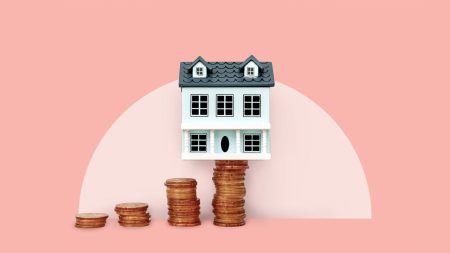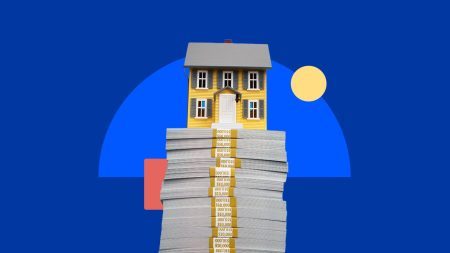Key takeaways
- Your income and the home’s price are the most important factors in determining how much you can afford to spend.
- But many other variables also play a role, including your location, your credit score, your other debts and the amount of your down payment.
- Make sure you have enough left over to cover potential emergencies and the ongoing costs of homeownership.
Before you begin home shopping, it’s important to assess just how much you can afford to spend. This is especially critical at a time when the market is dominated by steep home prices and elevated mortgage interest rates: The median existing-home sale price as of May 2025 was a record-high $422,800, according to the National Association of Realtors. And the average rate for a 30-year mortgage remains in the high 6 percent range.
Of course, home values and interest rates are just two considerations to bear in mind when calculating how much home you can afford. There are many other expenses associated with homeownership that impact your ongoing costs. And the amount you can spend on a home versus the amount you should spend may be two entirely different figures. Here’s what to consider when you find yourself wondering, “How much should I spend on a house?”
Determining how much you can spend
It typically makes sense to spend less than your maximum possible budget. “Prospective homebuyers should understand that just because a bank approves a certain loan amount doesn’t mean they should use the full amount,” says Taylor Kovar, CFP, founder and CEO of 11 Financial in Lufkin, Texas. “It’s important to consider other financial goals, monthly expenses and potential emergencies, and to understand what it means to be ‘house poor.’ A home is a long-term commitment, and ensuring you have financial flexibility is crucial.”
A number of variables play a role in how much house you can afford as a prospective buyer. Here are some big ones to consider:
- Location: The area you’re shopping in plays a significant role in spending calculations. While the median home price nationally is above $400,000, prices vary significantly across the country, and there are many more affordable housing markets where prices are quite a bit lower. Consider your desired area’s overall cost of living, as well — when daily necessities like food and transportation cost more, you’ll have less money available for monthly housing costs.
- Income: The amount of money you have coming in each month, and how stable that income is, is another primary consideration. There is no one income required to purchase a home, but you will need to be able to afford a down payment, closing costs and monthly mortgage payments, while also keeping up with your other debts.
- Savings: Having healthy cash reserves saved up is an important part of being prepared for the financial responsibilities of homeownership. The more you have set aside, the better you’ll be able to handle any unexpected emergencies while continuing to make your mortgage payments. “I advise having a minimum of six months of asset reserves available post-closing to create financial flexibility in the event something unexpected arises,” says Evan Luchaco, a home loan specialist for Churchill Mortgage. “Whether it be loss of a job, a significant home repair, needing to replace a vehicle — you always want to have that safety net in place.”
- Credit: Your credit score has a major impact on the mortgage interest rate a lender will offer you. Applicants with higher credit scores are likely to be offered the most competitive rates, which will help keep your monthly mortgage payments more affordable. If your score is on the low side, consider taking some time to work on raising it before seeking a mortgage.
Calculating DTI
Your debt-to-income ratio, is another important factor when determining how much to spend on a home. This figure, which measures all of your monthly debt against your total monthly income, helps lenders determine how much they’d be willing to loan you. The higher your DTI, the more concern lenders are likely to have about your ability to repay a loan, which increases their risk
“Most should not spend the max allowed on the debt ratio, since it will often leave them unable to adapt to any financial emergencies that may arise,” says Carlos Scarpero, mortgage broker with Edge Home Finance near Dayton, Ohio.
To calculate your DTI, add up all of your monthly debts and divide the sum by your monthly income.
While DTI limits vary by lender and loan program, many experts recommend adhering to the 28/36 rule. This rule serves as an important guideline for home affordability and states that borrowers should spend no more than 28 percent of their gross monthly income on housing expenses, while your total debt expenses, including your mortgage, should be limited to 36 percent of your income.
As an example, let’s say you earn $100,000 per year, which breaks down to $8,333 per month. Since 28 percent of $8,333 comes to $2,333, your housing costs should not exceed $2,333 per month, and your total debt costs should not exceed 36 percent of that amount, or $3,000.
Estimating your future house payment
What your monthly payment will be depends heavily on the cost of the house, of course, but also on the amount of your down payment, your loan length and your mortgage interest rate. The more you’re able to pay upfront in the form of a down payment, the less you’ll have to borrow — and the lower your rate, the less you’ll pay in interest.
Bankrate’s mortgage calculator can help you estimate what your monthly payment will be. For example, let’s say you’re looking to buy a house that costs $400,000. If you put down 20 percent, or $80,000, with a 30-year mortgage at 6.9 percent interest, your monthly principal and interest payments will come to $2,107. If you put down 20 percent with a 6.2 percent interest rate, though, that decreases to $1,959. If you put down only 10 percent at 6.9 percent, that amount increases to $2,370 — plus the cost of private mortgage insurance, which is typically required when a down payment amount is lower than 20 percent.
In any scenario, you’d have to also add in the cost of homeowners insurance premiums and property taxes, which vary widely by location.
Cost of homeownership
Don’t forget to consider the ongoing costs of maintaining a home once you actually own it. Regular upkeep can cost more than you think, especially on larger homes, so cash reserves are crucial. And your financial situation may change over the course of the mortgage term, so it’s smart to be ready just in case.
If the home you buy is located in a community that’s managed by a homeowner’s association, then HOA dues will also be part of your homeownership costs. These vary widely based on the HOA and what kind of services or amenities are provided.
Next steps
Before you start home shopping, crunch the numbers on your finances to pinpoint how much you can comfortably afford to spend. It’s also smart to get preapproved for a mortgage, which will give you a good idea of how much a lender would be willing to loan you.
Once you’ve got your budget squared away, it’s time to find a real estate agent. A local agent with expertise in the region you hope to buy in can be an invaluable partner, helping to identify listings that meet your needs and negotiating the best deal possible on your behalf.
FAQs
Why we ask for feedback
Your feedback helps us improve our content and services. It takes less than a minute to
complete.
Your responses are anonymous and will only be used for improving our website.
Help us improve our content
Read the full article here









